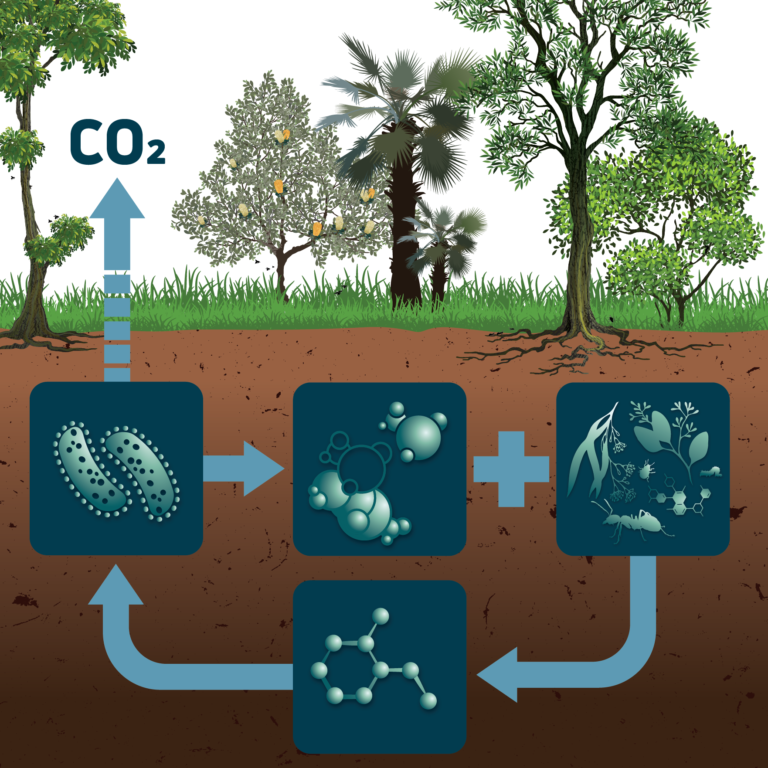For humans, the onset of the wet season in Australia can draw huge sighs of relief; it can also trigger a huge release of carbon dioxide from the newly drenched soil.
The amount of carbon stored in the world’s terrestrial ecosystems varies from season to season and from year to year. The Australian continent is the source of a lot of this variability, so understanding what is driving it is crucial not only for the accuracy of Australia’s annual carbon inventory but for global climate projections.
Soil respiration in Australia’s semi-arid regions at the onset of the wet season is a main driver, according to a new study published in Science.

The deluge of water that falls on the parched land results in the soil emitting great pulses of carbon dioxide (CO2) before the plants are ready to take it up through photosynthesis. This phenomenon of respiration responding to wetting ahead of photosynthesis following a long dry spell is not news — it was previously noted in 2009, based on 5 years of measurements collected from an eddy covariance tower sited at Skukuza in Kruger National Park, South Africa.
What is news is that the magnitudes of these pulses are 2–3 times larger than the previous studies have inferred, which means the Australian findings have important implications for global-scale carbon–climate modelling, especially in the area of feedback loops.
Satellite data can fill gaps in field observations
Semi-arid regions have previously been identified as hotspots affecting global year-to-year CO2 variability because photosynthetic carbon uptake is strongly sensitive to fluctuations in water availability.
And CO2 pulses have been extensively described in local studies of water-limited systems.
But until now their relevance at the continental scale has been unknown, largely because of the scarcity of in-situ observations in remote areas of Australia.
In this latest study, the researchers instead examined satellite earth observations of atmospheric CO2 concentrations from the Japanese operated Greenhouse Gases Observing Satellite (GOSAT) for the period 2009–2018.
What they found were recurrent CO2 pulses over the Australian continent, occurring shortly after the onset of rainfall in Australia’s semi-arid regions.
The GOSAT observations revealed a seasonal pattern above Australia, with CO2 drawdown in March, April and May and a CO2 peak of variable magnitude at the end of the dry season in October, November, and December.
Combining the data reveals shortcomings of in-situ observations
When the GOSAT CO2 concentrations and available in-situ CO2 measurements were fed into an atmospheric inverse model (TM5-4DVAR), the authors found that the pulses can be attributed to a carbon-release pattern originating from land ecosystems — a pattern that is not present in the in-situ CO2 data alone.
The combined data also estimated the seasonal variability of Australia’s carbon balance to be almost double that of the estimate from using in-situ observations alone, and the year-to-year variability more than 4 times greater.
These pulses largely account for the seasonal and year-to-year variations in Australia’s CO2 inventory for the 10-year period.
What causes the CO2 pulses?
To discover the origin of the CO2 pulses, the inversion estimates of CO2 were compared with estimates from 18 global vegetation models, 5 of which showed a pulse pattern similar to that of the satellite data.
These models revealed that the pulses originate mainly from an early increase of soil respiration in semi-arid regions.
In a long-understood process known as the “Birch effect”, dormant soil microbes are “awoken” by the moisture and quickly respire and reproduce.
In a race between soil respiration and photosynthesis, the soil microbes win, respiring CO2 before the plants are ready to take it up through photosynthesis.
How TERN’s flux data were used
The study used eddy covariance data collected by the TERN OzFlux facility, including carbon flux, soil moisture and precipitation data.

The TERN flux data were used to confirm the CO2 emissions from dryland ecosystems following rainfall, the wetting of the soil, and rapid growth of soil microbes.
“Australia’s semi-arid regions play a critical role in the Earth’s carbon cycle, as research supported by TERN’s OzFlux infrastructure has shown definitively. We are very excited to see this new work which shows the scale of carbon dioxide emissions from Australia’s soil”, said OzFlux director Jamie Cleverly.
The TERN OzFlux researcher network operates more than 30 eddy covariance flux towers in Australia and New Zealand. Performing complex calculations that use wind speed, temperature, humidity and gas concentration gradients, these flux towers continuously measure vertical exchanges of CO2, water vapour, and energy between terrestrial ecosystems and the atmosphere.
The eddy covariance flux data help us understand the mechanisms controlling these exchanges and measure the carbon and water balances of key ecosystems.
TERN OzFlux is part of an international network (FluxNet) of more than 800 flux stations that is designed to continuously monitor the state of ecosystems globally.
The implications for modelling carbon cycles and climate feedbacks
Soil respiration and its rate across ecosystems are crucial to understand because they play a large role in global carbon cycling (as well as other nutrient cycles).
The Science study calls for researchers to reassess the contributions of semi-arid systems around the world to variations in carbon inventories.
Soil respiration is also associated with positive feedback with global warming. Positive feedback is when a change in a system produces a response in the same direction of the change. In this case, soil respiration rates can be increased by global warming, which, in turn, can increase global warming.
Attributing variations in the global CO2 sink to specific regions and mechanisms is highly uncertain. Understanding how carbon emissions in semi-arid regions at the onset of the wet season may be attributed to soil respiration should improve our ability to model climate–carbon cycle feedbacks and project future climate.
By Mary O’Callaghan







